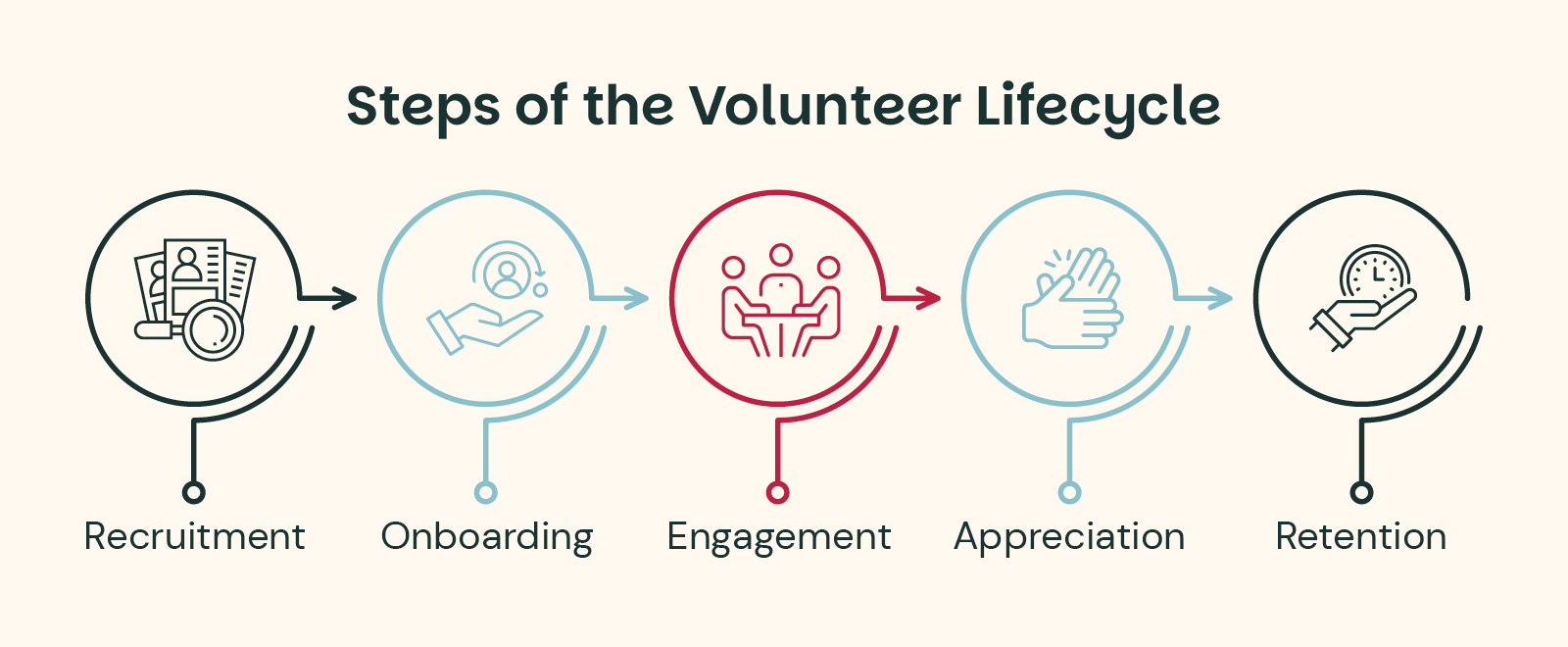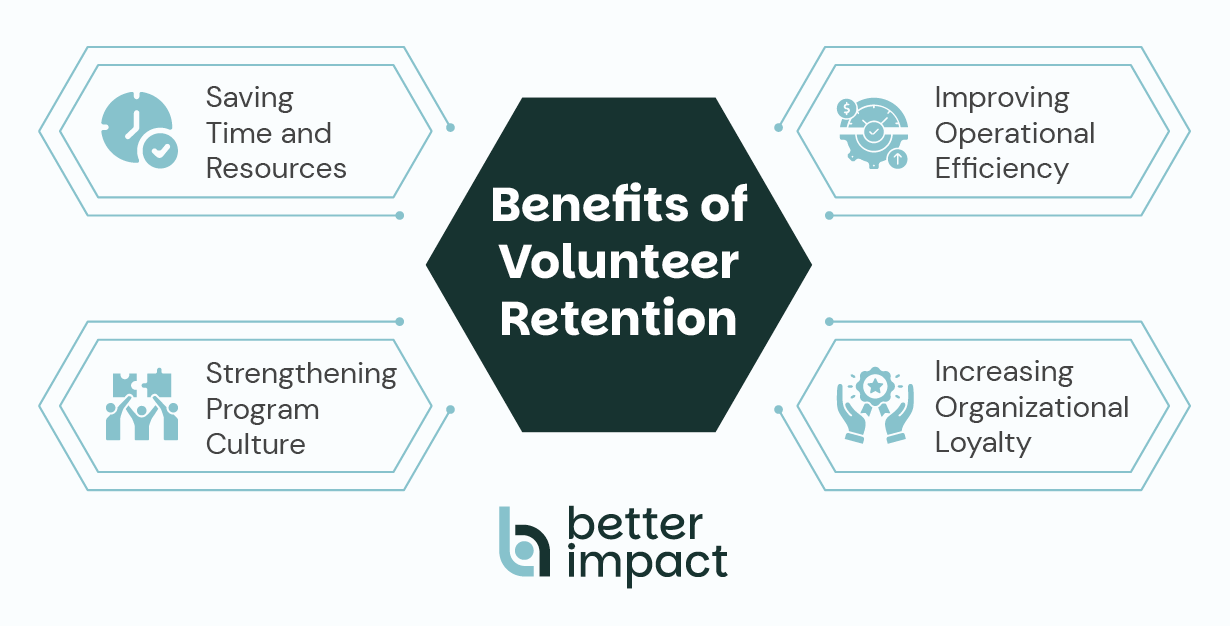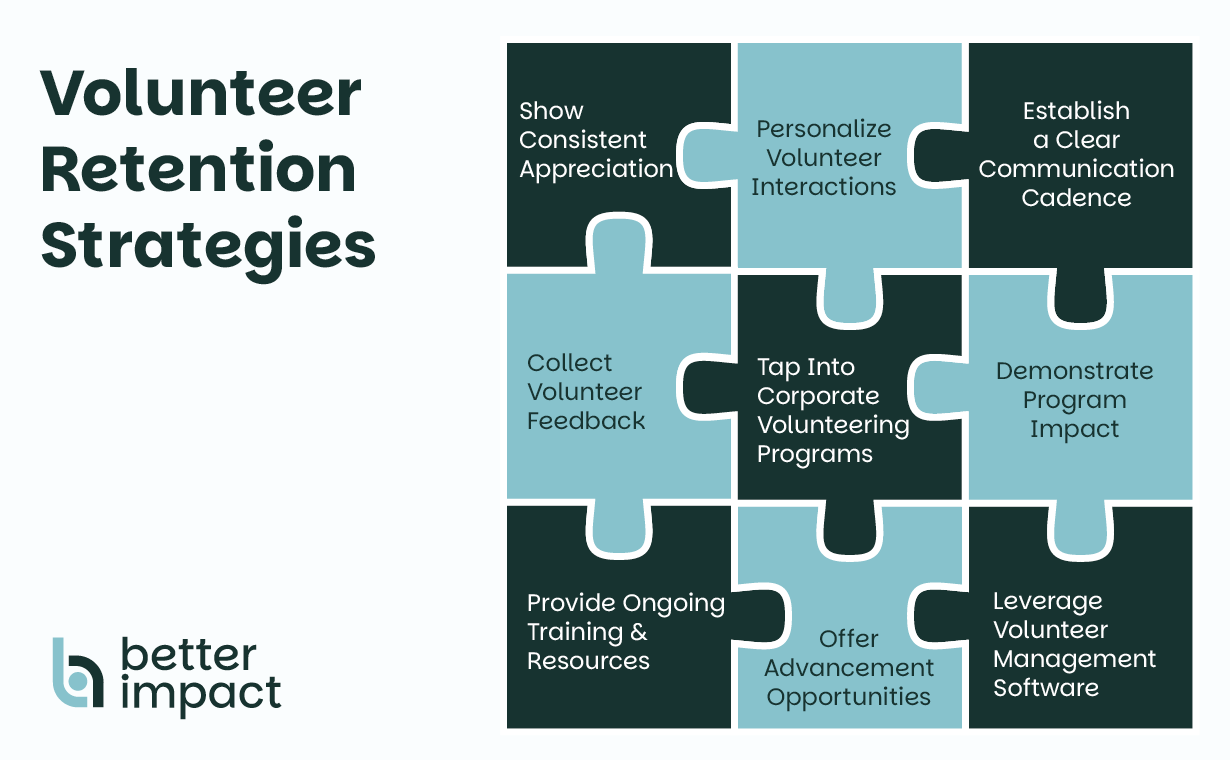Hot Take: Volunteer Burnout Burns Out Volunteer Engagement Professionals
We talk a lot about burnout in the nonprofit sector, and burnout is especially common among volunteer engagement professionals. According to a 2017...
9 min read
 Timothy Sarazen
Nov 6, 2025 12:05:38 PM
Timothy Sarazen
Nov 6, 2025 12:05:38 PM

It’s no secret that volunteers provide immense value to your organization through their contributions of time and talent. In fact, the average equivalent monetary value of just one volunteer hour was $34.79 as of 2024. And the longer a volunteer sticks with your organization, the more valuable their service becomes as they develop their skills and grow their passion for your mission.
However, keeping volunteers engaged long-term is among the top five challenges today’s volunteer managers face. To help your organization overcome this obstacle, this guide will cover everything you need to know about volunteer retention, including:
Let’s get started by ensuring we’re on the same page about what volunteer retention is and why it matters.
Volunteer retention describes your organization’s ability to keep volunteers actively involved in your work long-term. The term can also refer to the strategic process of encouraging this repeated, lasting engagement in your program.
Volunteer retention is the final step in the volunteer management lifecycle, meaning every other aspect of volunteers’ journeys and experiences with your organization builds toward it as follows:

Retention may be the end goal of the volunteer journey, but it’s also an ongoing process that requires continuous effort and monitoring.
Retaining volunteers provides several benefits for your organization, including:

Your volunteer retention strategy shouldn’t replace your efforts to attract new volunteers when possible—recruitment is still essential for your program to grow. However, retaining volunteers allows your program to be successful and sustainable for years to come.
The opposite of volunteer retention is volunteer attrition or churn, which occurs when a volunteer terminates their involvement with your organization. Volunteers who haven’t engaged with your program for a defined period of time (often a year or six months) are known as lapsed volunteers.
Some common reasons for volunteer churn include:
Knowing why your organization’s volunteers might disengage allows you to develop strategies that proactively prevent attrition. For example, if you discover that volunteers are dissatisfied with your current approach to communication, you could experiment with different cadences until you find the right messaging frequency. Or, if volunteers are leaving due to shifts in their personal lives, you might offer more flexible shift options and pilot virtual roles so it’s easier to fit volunteering into a busy schedule.
Volunteer retention rate is one of the most important metrics to track and analyze to determine your program’s overall success. It shows the percentage of volunteers who stay involved with your organization from one defined time period (year, quarter, event, etc.) to the next.
To calculate your volunteer retention rate, use the following equation:
.png?width=1230&height=492&name=volunteer%20retention_rate%20(1).png)
For example, if your organization had 200 total volunteers last year and 120 served again this year, your year-over-year volunteer retention rate would be (120/200) x 100 = 60%.
You can also use this calculation to determine retention rates for individual volunteer activities. For instance, if 40 volunteers helped with your last 5K fundraiser and 28 come back to work your next 5K, your volunteer retention rate for this event would be (28/40) x 100 = 70%.
Reports vary on the average volunteer retention rate across the nonprofit sector—65% is a common figure, although some studies claim numbers as high as 75% or as low as 45%. The 65% benchmark is typically a solid target to aim for year-over-year.
Although many organizations focus heavily on retention rate as an indicator of volunteer program success, remember that tracking other metrics can provide deeper insights and a more holistic picture of how your efforts are going. These may include total active volunteers, total volunteer hours tracked, participant satisfaction ratings, average volunteer lifetime value, and return on investment (ROI) for your program.
Now that you’ve gotten the lay of the land, let’s dive into how to practically encourage lasting engagement at your organization by reviewing some of the best volunteer retention strategies.

Although appreciation and retention are often considered separate steps in the volunteer management lifecycle, they actually overlap significantly. Expressing gratitude is the most effective way to demonstrate that you value your volunteers, which is critical for retaining them.
Depending on your volunteers’ unique preferences, you might recognize them by:
Formally thank volunteers using these methods to commemorate notable occasions, such as the first time they serve or a milestone in their journey. Other customary annual occasions, like the end of the year and National Volunteer Week, are also great opportunities to express your gratitude.
Don’t underestimate the value of informal appreciation, either—a quick “Thanks for your help!” or “Great work today!” from a supervisor at the end of a shift can leave a lasting impression that motivates a volunteer to sign up again.
As mentioned previously, effective volunteer communication is a delicate balance. Not contacting volunteers often enough can make your messages get lost in the shuffle, but reaching out too frequently can lead to fatigue and burnout. And of course, all of your communications need to be well-written and highlight the action you want recipients to take (if there is one).
Play around with your communication cadences until you find a schedule that gets as many volunteers as possible to open your messages and take the intended next step. Different groups of volunteers will likely appreciate different communication frequencies—for example, you’ll need to contact volunteers who serve monthly or semimonthly much more often than those who only help out with one event a year. You might also contact volunteers through various channels (email, text, social media, etc.) to keep your approach fresh and your messages visible.
Nothing says to volunteers, “We care about you as an individual,” more than personalization. Whenever possible, your communications should be tailored to each recipient, meaning they:
All of these communication tactics demonstrate that your organization knows each of its individual volunteers. This personal knowledge should extend to interactions between staff members and the volunteers they supervise, too. Remembering volunteers’ names and expressing an interest in their lives will strengthen relationships within your program.
Of the reasons people choose to volunteer, the most common one is (unsurprisingly) wanting to make a difference for a cause they care about. Regularly let volunteers know their contributions are having their desired impact by sharing:
Additionally, consider creating periodic impact reports for your volunteer program. Impact data not only shows volunteers that they’re continuing to make a difference, but it also encourages them to stay engaged. Not to mention, these reports are an easy way to demonstrate the value of your volunteer efforts to other stakeholders and potential new recruits.
To help your volunteers increase their impact even more, you can turn to their employers. Many businesses offer volunteer programs to give back to organizations and causes their employees care about, which often boosts their retention rates and their reputations as socially responsible companies.
Research companies in your area to see if they offer any corporate volunteer initiatives, such as:
Then, promote these opportunities to supporters so they can check their eligibility and use the perks they have access to as they continue volunteering with you. Over time, tapping into these programs can foster mutually beneficial, lasting relationships between your organization and local companies.
Longtime volunteers often want to improve the organizations they contribute to and have a say in their future. Actively collecting feedback lets volunteers know you welcome their input and always want them to have the best possible experience in your program.
Send out periodic surveys (e.g., quarterly or semiannually) that include a variety of multiple-choice and open-ended questions about different aspects of volunteering. You might also check in with a few individual volunteers one-on-one to see how they’re feeling about your program and gather any suggestions they may have for the future.
Then, review your collected feedback, choose the best ideas to implement, and communicate about the changes you’re making. You probably won’t be able to use every suggestion, and you should also let volunteers know why you didn’t choose to move forward with certain ideas to ensure they know you still took their thoughts into consideration.
Too often, volunteers’ training ends when they’re fully onboarded into a program, even though many volunteers want to continue building their skills past that point. To fulfill this desire, your organization may offer:
In addition to preventing volunteers from feeling bored or stagnating in their roles, ongoing training can lead to a more skilled volunteer pool overall, meaning your program can run more efficiently and make a bigger impact.
Another way to reduce the risk of stagnation and recognize volunteers’ achievements is to empower them through higher-level opportunities. These may include:
Don’t pressure volunteers to take on these new responsibilities if they don’t want to. However, letting them know that these options are open to them demonstrates that you’ve noticed their dedication and want them to keep up the good work.
Like most operations in the modern nonprofit world, volunteer retention becomes much easier when you have the right tools on your side. Your organization’s volunteer management software should help you consolidate and streamline every stage of the volunteer lifecycle, but here are a few features to look for that will specifically help you execute the other retention strategies we’ve discussed:
For a platform that includes all of these features and more in a unified, user-friendly system, look no further than Better Impact! Our volunteer management solution, Volunteer Impact, makes it easy to retain volunteers without letting other essential aspects of your program fall through the cracks. Plus, we offer personalized customer support and a robust library of training videos to help you make the most of your software and your organization’s volunteer efforts.
But don’t just take our word for it—check out our client case studies to see how real organizations of all sizes and missions have used Better Impact’s tools to improve their volunteer retention strategies and much more!
Volunteer retention is the key to building a program that thrives long-term and supports your organization’s mission for years to come. Use the strategies in this guide to get started, and make sure you have the right technology on your side (i.e., a comprehensive volunteer management platform like Volunteer Impact) to help you adapt your approach to your unique needs, goals, and supporter preferences.
For more information on various aspects of volunteer management, check out these resources:

Featured Posts

We talk a lot about burnout in the nonprofit sector, and burnout is especially common among volunteer engagement professionals. According to a 2017...

Your church’s volunteers provide critical support for its ministry, which congregants are increasingly realizing as they seek ways to deepen their...

As a volunteer coordinator, you know how critical volunteers are to your nonprofit’s activities. Whether they’re in hands-on roles with...